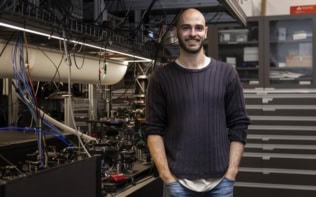
If two particles are “entangled”, so quantum mechanics says, any tinkering with one can cause an instantaneous change in the other, no matter how separated they are.
Einstein rejected this notion as “spooky action at a distance”. But what if quantum mechanics is not quite right — that the change is not instantaneous, but instigated by a signal transmitted between the two entangled particles? Now an experiment performed in Switzerland has showed that, if such a signal does exist, it would have to travel at least as fast as light, and probably thousands of times faster.
The experiment, which has been performed by Nicolas Gisin and colleagues from the University of Geneva, is similar to other experiments that attempt to test entanglement, albeit on a larger scale. The researchers first entangle two photons at Geneva, and then send them 9 km in opposite directions — due east and west — to interferometers based at the Swiss villages of Jussy and Satigni. At these two locations they look for any interference between the photons. If the interference is above a reasonable level — given by the so-called Bell inequality — it implies the photons are changing their properties instantaneously to suit each other.
Any reference frame
On its own, this experiment would not rule-out the possibility that the photons are signalling to one another. This is because, according to Einstein’s theory of special relativity, the measurements may not be synchronous from the point of view of a moving observer or “reference frame”. In other words, there may be a finite time gap for the signal to be sent.
To get around this, Gisin and colleagues performed their experiment many times over a 12-hour period. The rotation of the Earth throughout this time means that the researchers could put a limit on the duration of the time gap for any reference frame. They found that even for a reference frame that would produce the biggest gap — one moving relative to the Earth at close to the speed of light — the signal itself would have to travel more than 10 times the speed of light. For more realistic reference frames — say, one moving at a thousandth the speed of light relative to Earth — the signal would have to travel even faster, at more than 10,000 times the speed of light (Nature 454 861)
Gisin told physicsworld.com that his team’s work, which is the first time the possibility of any hypothetical reference frame has been taken into account, “confirms the predictions of quantum theory”. He also hopes it will enable other researchers to find a more palatable explanation for the mysteries of entanglement.



